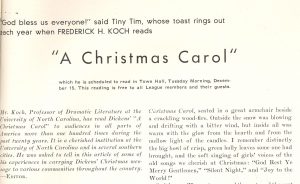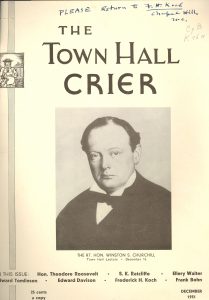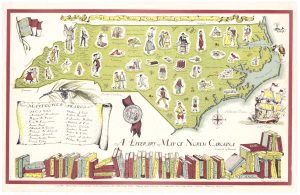
“Far away, it seems now, on the winter prairie of Dakota I was impelled with the desire to read again for my own enjoyment Charles Dickens’ immortal ghost story, A Christmas Carol. Fresh from Harvard, I was then a very young instructor at the State University of North Dakota. That was twenty-five years ago, although I can scarcely admit the passing of so many years. In that lonely isolation on the Great Flat I was pretty homesick, I guess, when I thought of the cheerful fireside associations I had left behind me in the sheltered East–of home, and friends, at Christmas time….
“It was a Sunday afternoon that I read the story, and I felt myself greatly cheered by it. So much so, that I mentioned the fact to a little group at supper in the University Commons that evening with the comment: ‘Everybody ought to read Dickens’ Christmas Carol every year before Christmas.’
“The Dean of Women spoke up: ‘Well, if you feel that way about it, you ought to read it for us!’ On the following Sunday afternoon, the last Sunday before Christmas, I read A Christmas Carol, seated in a great armchair beside a crackling wood-fire. Outside the snow was blowing and drifting with a bitter wind, but inside all was warm with the glow from the hearth and from the mellow light of candles. I remember distinctly the big bowl of crisp, green holly leaves some one had brought, and the soft singing of girls’ voices of the old songs we cherish at Christmas: ‘God Rest Ye Merry Gentlemen,’ ‘Silent Night,’ and ‘Joy to the World!’
“So it began. The next year, and the next, and the next.”
-Frederick H. “Proff” Koch in an article penned for the December 1931 issue of The Town Hall Crier, a publication of the New York City-based League for Political Education. The article ran in advance of Koch’s reading of A Christmas Carol at Town Hall on December 15, 1931. The League for Political Education built Town Hall, a meeting space and concert hall, on 43rd Street in New York City in 1921.
An editor’s note preceding the article records that Koch, founder of the Carolina Playmakers at the University of North Carolina, had read the Dickens’ classic “to audiences in all parts of America more than one hundred times during the past twenty years.”

Koch’s 11 a.m. reading on Dec. 15 was to precede a lecture by Winston Churchill later in the day. Churchill’s talk was postponed after the British statesman was struck by a car on Fifth Avenue and hospitalized. Koch’s invitation likely came from UNC and Carolina Playmakers alum George V. Denny Jr., Town Hall’s associate director at the time. Denny would eventually assume leadership of Town Hall and also start (and serve as host for) the NBC Radio program America’s Town Meeting of the Air, broadcast live from the 43rd Street venue.



